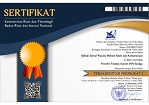The accuracy of online-based prayer times applications
Abstract
There are various types of prayer times that Muslims refer to on a daily basis. Specifically, there are offline and online prayer times as well as traditional and modern prayer times. Online prayer times that can be accessed from a mobile phone in forms such as android-based applications, online websites, and Google applications. The purpose of this study is to investigate the accuracy of online-based prayer times applications and seek for the possible consistency across these applications. This study employs a qualitative approach and a descriptive data analysis. The data collection is conducted through observations, literature study, and in-depth interviews. This study indicates different degree of deviations among online-based prayer times applications, in which Google applications show the most deviation among the others. This study suggests that Muslims refer to online applications recommended by the Ministry of Religious Affairs of Indonesia.
Keywords
Full Text:
PDFReferences
Ali, M. S. (1997) Ilmu Falak. Jakarta: Raja Grafindo Persada.
Amri, T. (2014) ‘halat dalam perspektif syar’i’, Asy-Syari’ah, 16(3).
An-Naisaburi, A. a.-H. M. b. a.-H. a.-Q. (2010) Shahih Muslim. Beirut: Maktabah Fayyadh.
Ardliansyah, M. F. (2017) ‘Implementasi titik koordinat tengah kabupaten atau kota dalam perhitungan jadwal waktu salat’, Al-Ahkam, 27(2), pp. 213–240.
Azhari, S. (2007) Ilmu falak perjumpaan khazanah Muslim dan sains modern. Yogyakarta: Suara Muhammadiyah.
Gautama, S. E. (2010) Astronomi dan astrofisika. Makassar: Makassar Press.
Hadi, H. D. H. (2009) Sains untuk kesempurnaan ibadah. Yogyakarta: Prima Pustaka.
Hafez, A., & Zeki, A. M. (2016) ‘Offline prayer times system’, Journal of Advanced Science and Engineering Research, 6(2), pp. 1–6.
Ilyas, M. (1984) A modern guide to astronomical calculation of Islamic calender, times, and qibla. Kuala Lumpur: Berita Publishing.
Islam, D. B. M. (2010) Almanak hisab rukyat. Jakarta: Kementerian Agama RI.
Khazin, M. (2005) Kamus ilmu falak. Yogyakarta: Buana Pustaka.
Khazin, M. (2007) Ilmu falak dalam teori dan praktek. Yogyakarta: Buana Pustaka.
Mohamoud (2007) ‘Tracing the shadow: Mathematical calculation of prayer times using spherical trigonometry’, Middle-East Journal of Scientific Research, 25(8), pp. 1650–1663.
Niri, M. A. et al. (2012) ‘Astronomical determinations for the beginning prayer time of Isha’, Middle-East Journal of Scientific Research, 12(1), pp. 101–107.
Noor, L. A. H., Rosyadi, F. F. and Hamdani, S. (2018) ‘The dawn sky brightness observations in the preliminary Shubuh prayer time determination’, QIJIS: Qudus International Journal of Islamic Studies, 6(1), pp. 25–38.
Ray, S. (2012) ‘Calculation of sun position and tracking the path of sun for a particular geographical location’, International Journal of Emerging Technology and Advanced Engineering, 2(9), pp. 81–84.
Rojak, E. A. (2021) Ilmu falak hisab pendekatan Microsoft Excel. Jakarta: Kencana.
Rojak, E. A., Hayatudin, A. and Yunus, M. (2017) ‘Koreksi ketinggian tempat terhadap fikih waktu salat: Analisis jadwal waktu salat Kota Bandung’, Al-Ahkam, 27(2), pp. 241–266.
Yudhana, A., Fadlil, A. and Rosad, S. (2019) ‘Jadwal sholat digital menggunakan metode ephemeris berdasarkan titik koordinat smartphone’, IT Journal Research and Development (ITJRD), 3(2), pp. 30–43.
Interview
Fahmi,I., 12 October 2020.
Mulyawan, A.S., 7 January 2020.
Supriyatna, E., 23 January 2020.
DOI: https://doi.org/10.18326/ijtihad.v21i1.21-38
Refbacks
- There are currently no refbacks.

This work is licensed under a Creative Commons Attribution-ShareAlike 4.0 International License.
Ijtihad: Jurnal Wacana Hukum Islam dan Kemanusiaan by http://ijtihad.iainsalatiga.ac.id/ is licensed under a Creative Commons Attribution-ShareAlike 4.0 International License







